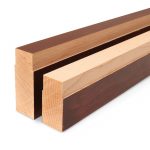We may receive a commission when you use our affiliate links. However, this does not impact our recommendations.
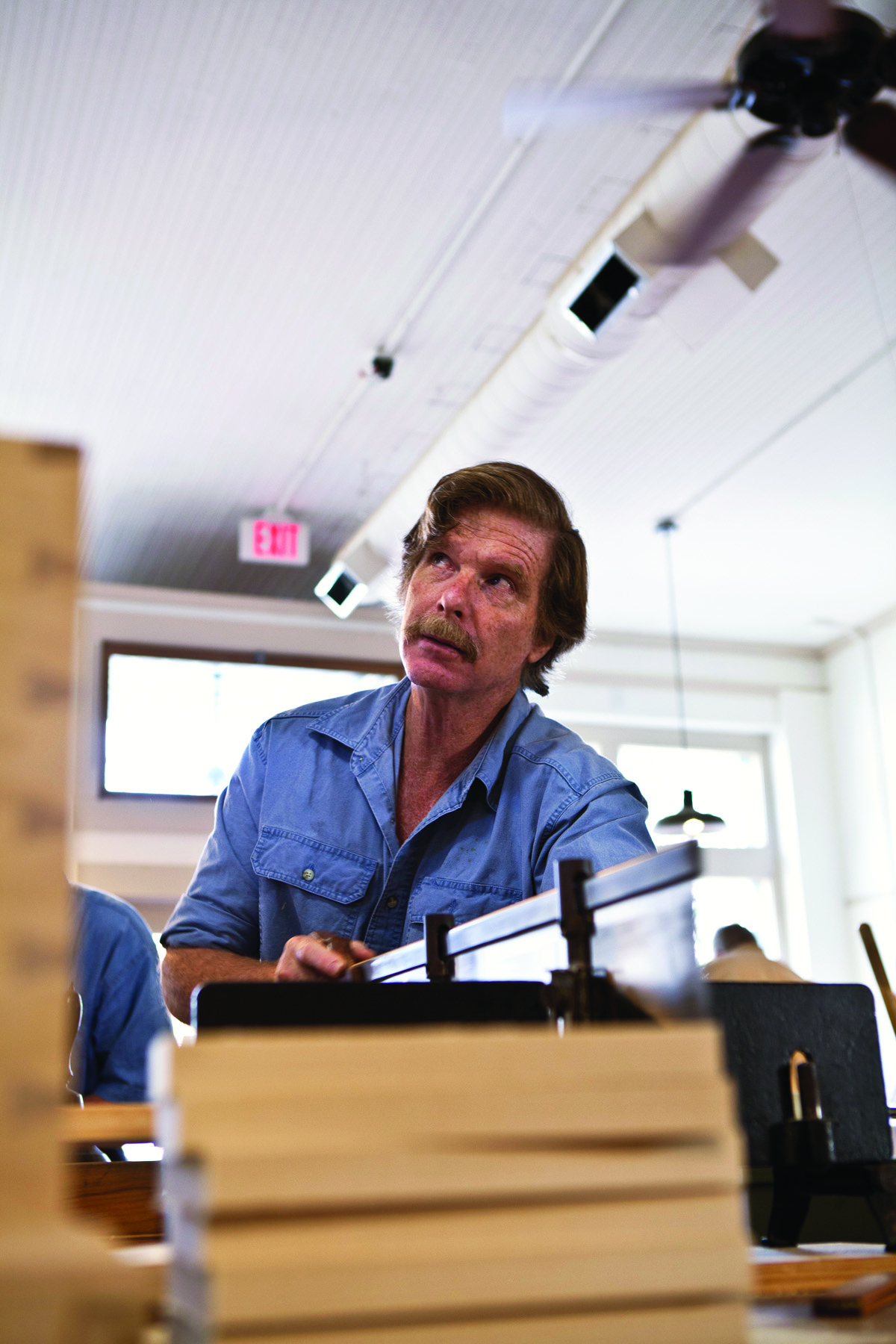
Work & ham. When a camera is involved, you can count on a funny expression. Here’s Roy as he prepares stock for an upcoming class.
More than 30 years on TV hasn’t softened his approach to the craft, tools or people.
Editor’s Note: This interview originally appeared in the November 2012 issue of Popular Woodworking
It’s a typical day at The Woodwright’s School in Pittsboro, N.C. Sunlight floods the storefront room through two enormous plate-glass windows. Six students carve ball-and-claw feet at their German workbenches while 1930s-era music tinkles through the air.
Something crazy, radical, and perhaps dangerous is about to happen.
Roy Underhill makes the rounds at the benches. He checks on each student, cracks a few jokes and retires to his miter box to crosscut the material for the next day’s class.
A bell rings. The door to the school opens and in walk two women and a man. They stand at the entrance and look a tad bewildered, as if they accidentally stepped into a small flaw in the space-time continuum in this small Southern town.
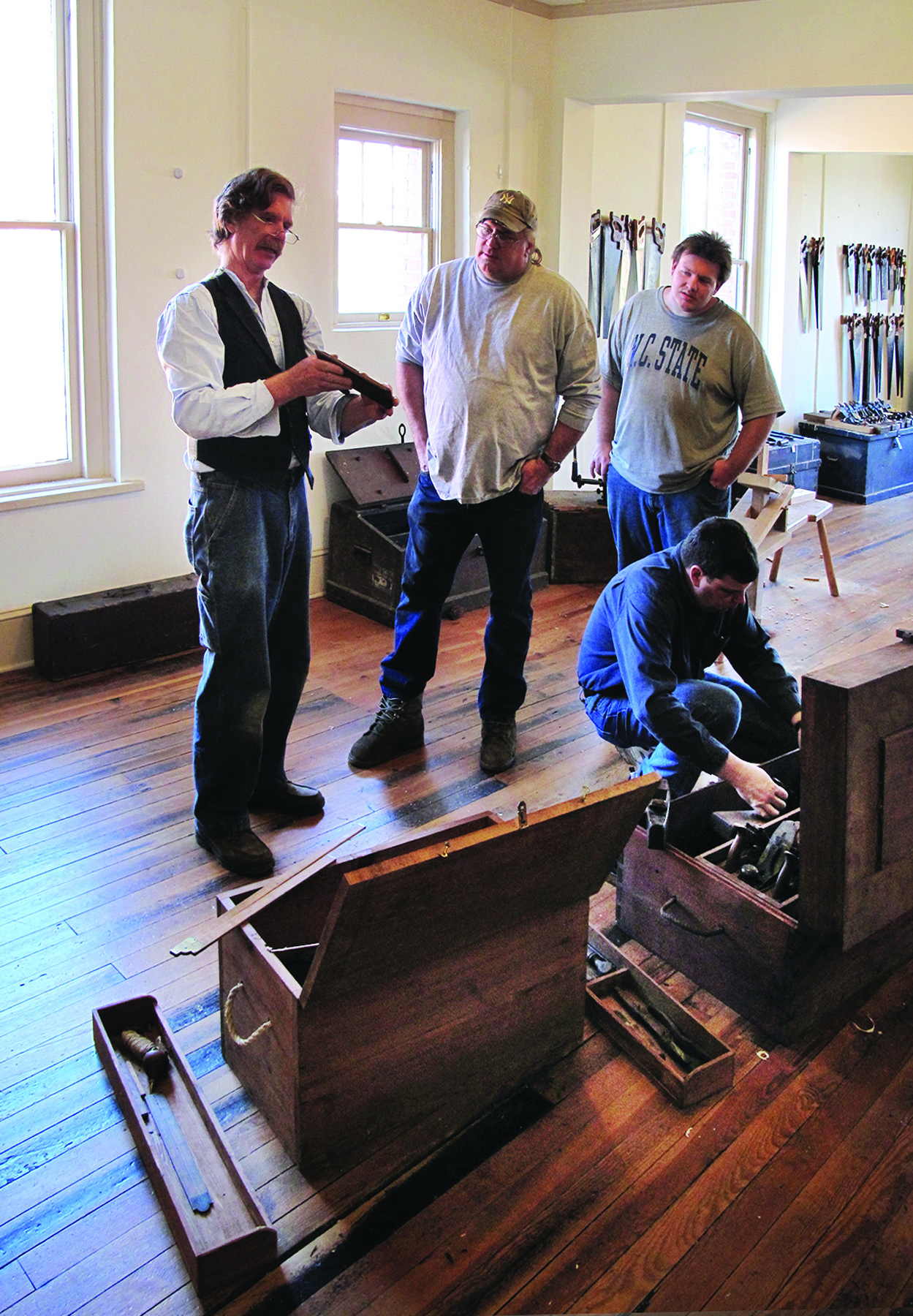
Professor Underhill. It’s tough to catch Roy Underhill with his guard down. Here he is examining a chest of tools that was brought to The Woodwright’s School to sell to Ed Lebetkin, who runs a tool store above the school.
Within seconds Roy and instructor Mary May are in front of them, all smiles and welcoming them into the shop. They invite them to look around at the benches, they explain what the students are doing. And they talk as if nothing unusual at all is going on in the bench room.
The students play along. They chat up the visitors, who gawk at the work on the bench, ask questions about the tools and still look a bit confused, but pleased.
After about 15 minutes the visitors leave, and the room falls silent again as the students return their full attention to their work.
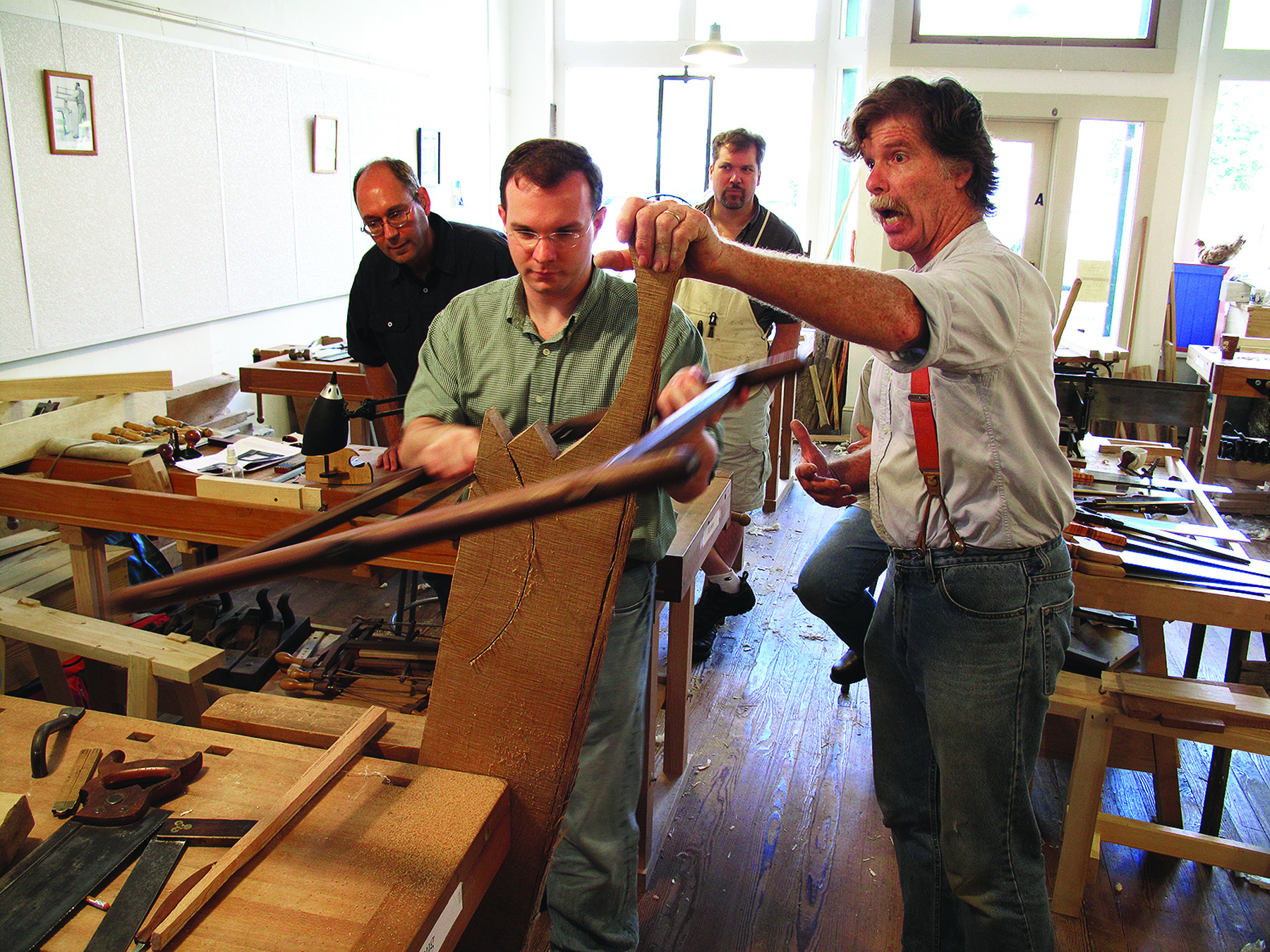
I saw this. When Roy teaches, his energy is directed entirely on engaging the students instead of on the work itself. It might sound like an odd approach, but it works incredibly well.
This scene is repeated almost every day at Roy’s small school. It is the unintended consequence of Roy opening his shop to students and the public a few years ago.
“I had this revelation about a month ago,” Roy says. “I wanted to do the subversive woodworking thing with my school. But I didn’t want to open it in a resort area because there you aren’t working as an activist, you are preaching to the converted. Somehow I had the idea that the school should be in an old downtown.
“Then I got it. It’s that window on the street – that’s where you are making the change. That is where the subversive work is being done.”
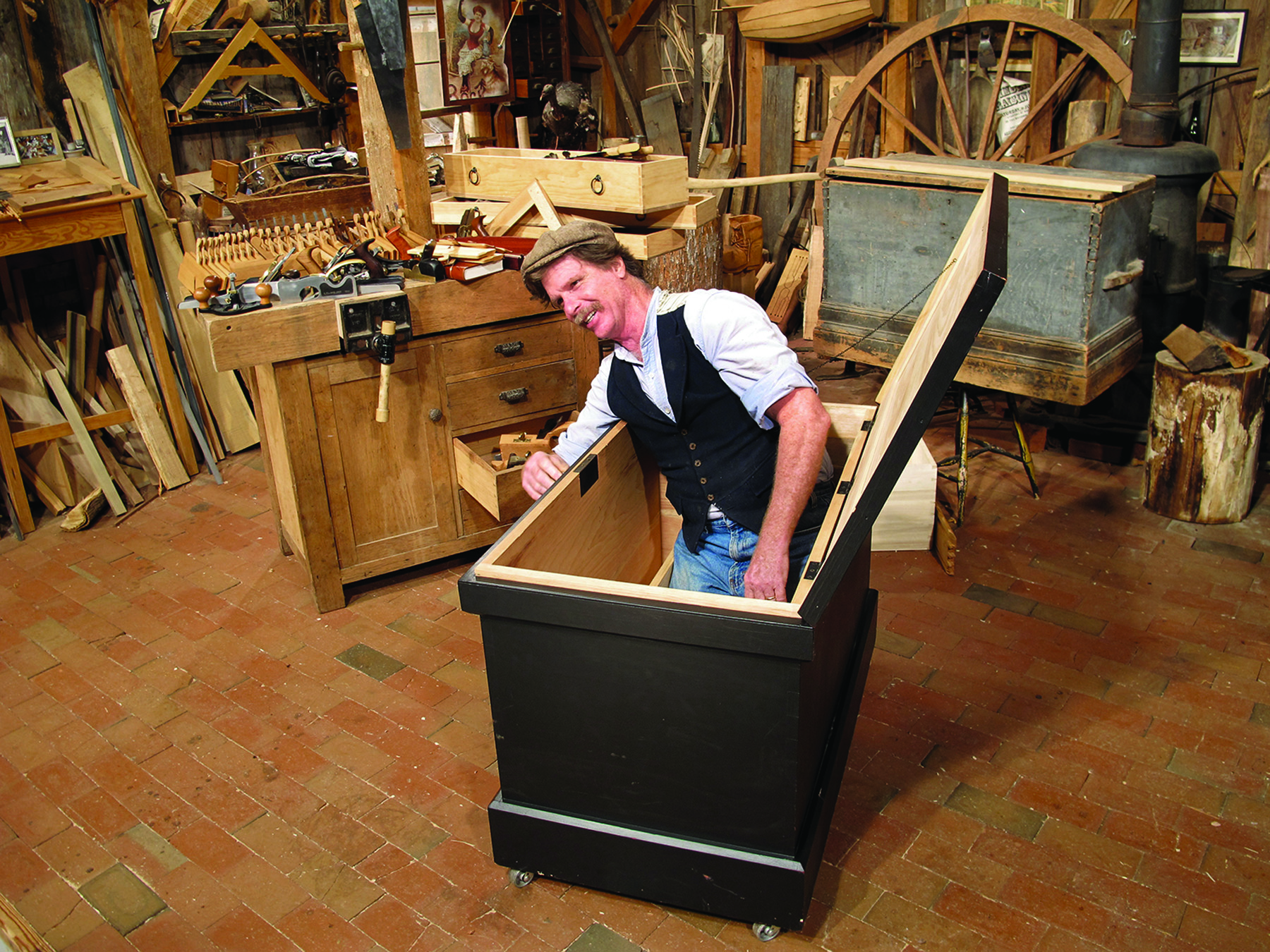
Gets you right in the chest. Every episode of “The Woodwright’s Shop” involves some sort of gag. Here Roy prepares to fold himself into a tool chest.
Indeed, many of the tourists who visit the school are genuinely floored to see ordinary people make things with their hands and not machines. Some of the visitors say they have distant relatives who used to build furniture or something with wood. But for many of them, it has never occurred that what happens within those four walls is even possible.
For Roy, what happens within those four walls is a simple continuation of his entire adult lifetime. Born in 1950, Roy grew up in the nation’s capital and had his first brush with the future as a boy.
“When I was 11,” he tells his students at the bar behind his school one night, “I was pretending to host my own woodworking television show. So that just goes to show you that what you were doing at age 11 could be your destiny.”
I kept at him with more questions. What, I asked, do you remember about making up your own show?
Roy says his family had a hand-cranked grinder in their shop, and he vividly remembers pretending to be on television while grinding away on a piece of wood that was on its tool rest.
“And I remember saying to the pretend camera: ‘Don’t let me catch you doing this at home!’” Roy says. “So nothing changes – I mess something up on the show and say, ‘Well… you get the idea.’”
Roy Underhill is not from the Past
Many people think that Roy Underhill is all about returning to the past. They couldn’t be more wrong.
I spent an evening with Roy and a group of North Carolina woodworkers at City Tap – the bar behind The Woodwright’s School – where Roy said some choice things about his philosophy on life and work.
There Roy told the story of when he was invited to be on a radio program with other guests that was titled “The Past, the Present and the Future.”
“They hired me to be the guy representing the past,” Roy says, sounding a bit astonished. “I’m not the past. I’m all about the future. What I do is the future.”
That’s a shocking statement to hear after viewing more than 30 years of his television program, which barely acknowledges the existence of electricity. But Roy insists he’s not seeking to explain the past so we can understand it. Instead, he is seeking only to influence the future course of human events.
“We don’t have to be helpless consumers,” Roy says, “when we can still be craftsmen.”
And that is the real lesson Roy has been trying to teach us for the last three decades. And it is something that flows through the way he treats people (even people who don’t know Roy Underhill from a hill in the ground). Yes, he looks like the rube on television sometimes, but inside beats the heart of a professor, a historian, a craftsman, and an entertainer.
He structures his program so it moves fast, almost like you are being mugged, and it is filled with messages that stretch back to the beginnings of civilization and stretch forward beyond our time here.
Will we merely consume the resources around us? Or will we build something that outlasts ourselves and everyone we know?
Off the Commune & Into History
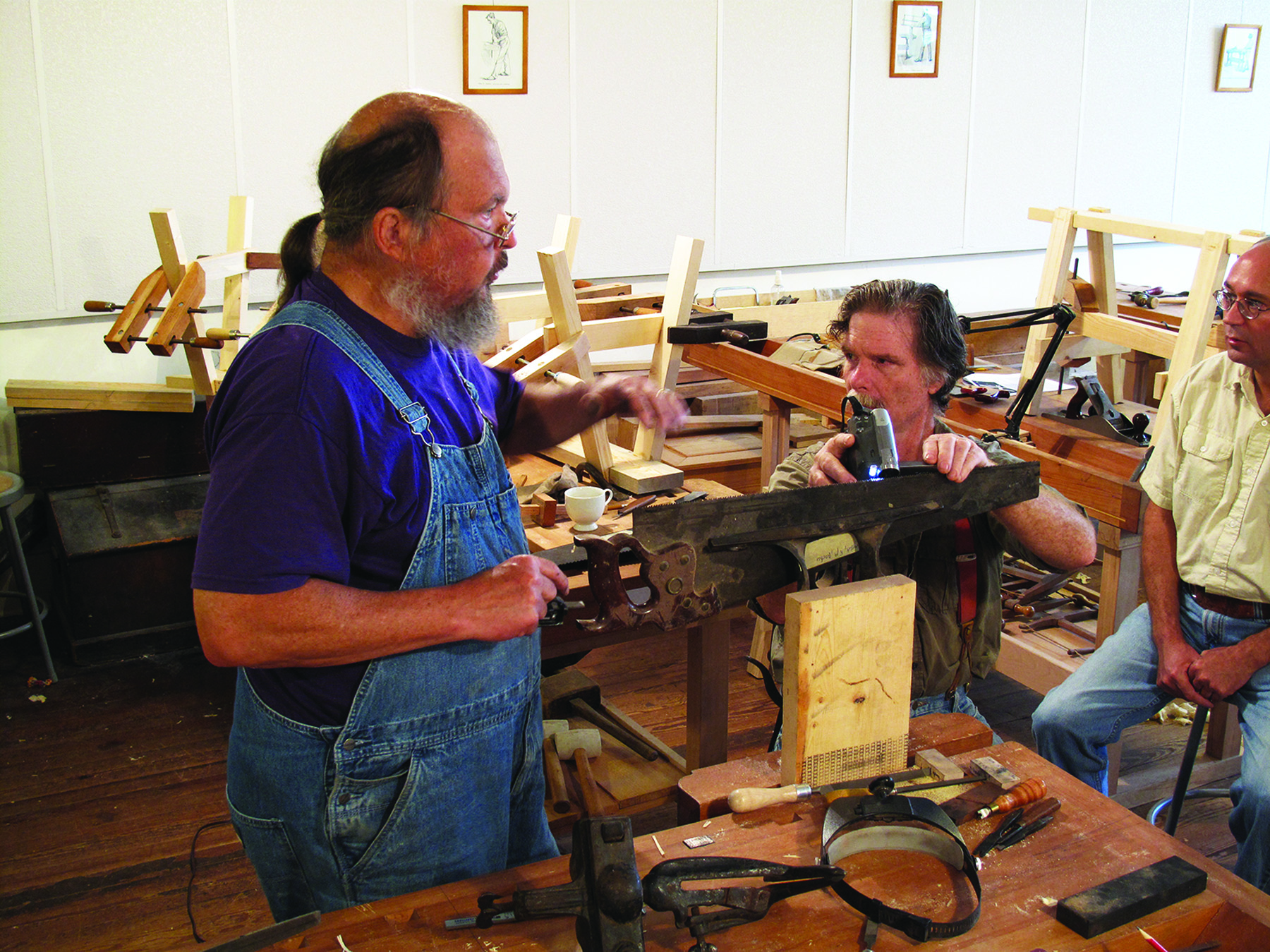
Cameraman. When a guest instructor teaches at The Woodwright’s School, Roy uses a macro camera to project the action onto a screen for the students. Here Bill Anderson demonstrates saw-tooth geometry.
Most people are surprised at first to hear that Roy was a theater major at the University of North Carolina at Chapel Hill (where he trained to be a director and paid for his education by building sets). But after a couple seconds of thought, they get it. After heading to Colorado to start a theater troupe, Roy and his wife, Jane, moved to a commune in New Mexico that was 17 miles away from the nearest power line.
One day, Roy went to Albuquerque to visit one of Jane’s former professors, who just happened to be a tool collector.
“He had-foot powered table saws and jigsaws and all these incredible tools. I realized there was this whole technology that had developed and that was flourishing before rural electrification in the 1930s. That was a real revelation for the practical solutions for living the way we did.” So at first, Roy’s interest in muscle-powered work was purely practical – how to make a living in the wilderness when he wasn’t doing freelance demolition work with dynamite and very little training.
Eventually, the Underhills moved back to North Carolina where Roy pursued a master’s at Duke University, studying forestry and the environment.
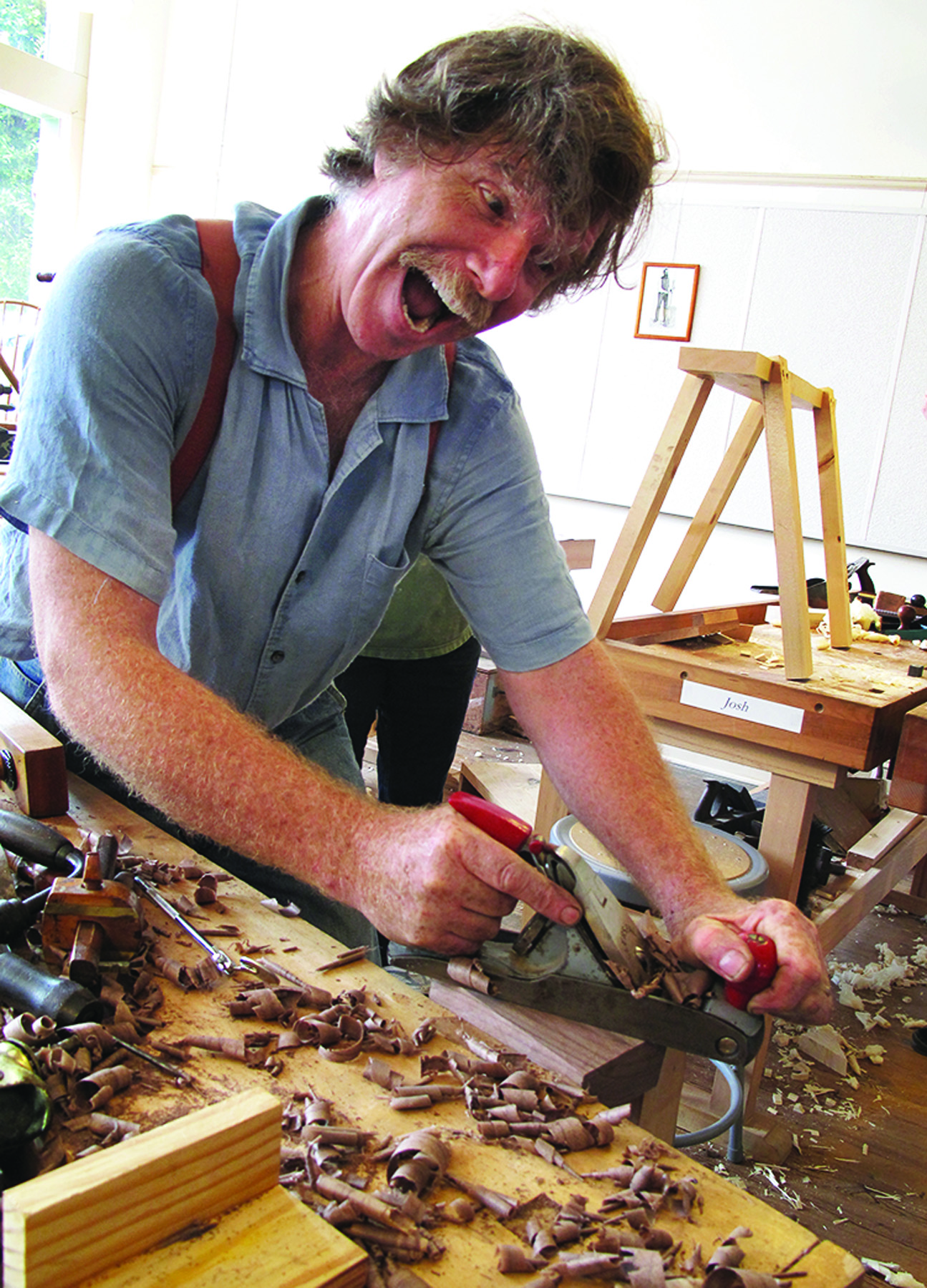
Stock prep made fun. On any given day, Roy is preparing stock – by hand – for a future class. Here is is planing down the heads for one of his “Mystery Mallet” classes.
“I began dealing with the environmental science, about what was happening to the planet. Even 35 years ago the evidence was that global warming was happening because of fossil fuel. So this thing about muscle-powered tools was not just for the survivalist. It was for the person who wants the planet to survive, too.”
Roy’s master’s thesis project was on muscle-powered woodworking, and he gave his presentation to fellow students and professors on a hillside at Duke – demonstrating the tools and how they worked with the material.
“Someone came up to me afterward and said, ‘Wow. This would work on TV.’ I said, ‘Oh my gosh, I think it will.’”
Then Roy pauses for a moment.
“I must have cut myself or something,” he says.
The Lucky Breaks
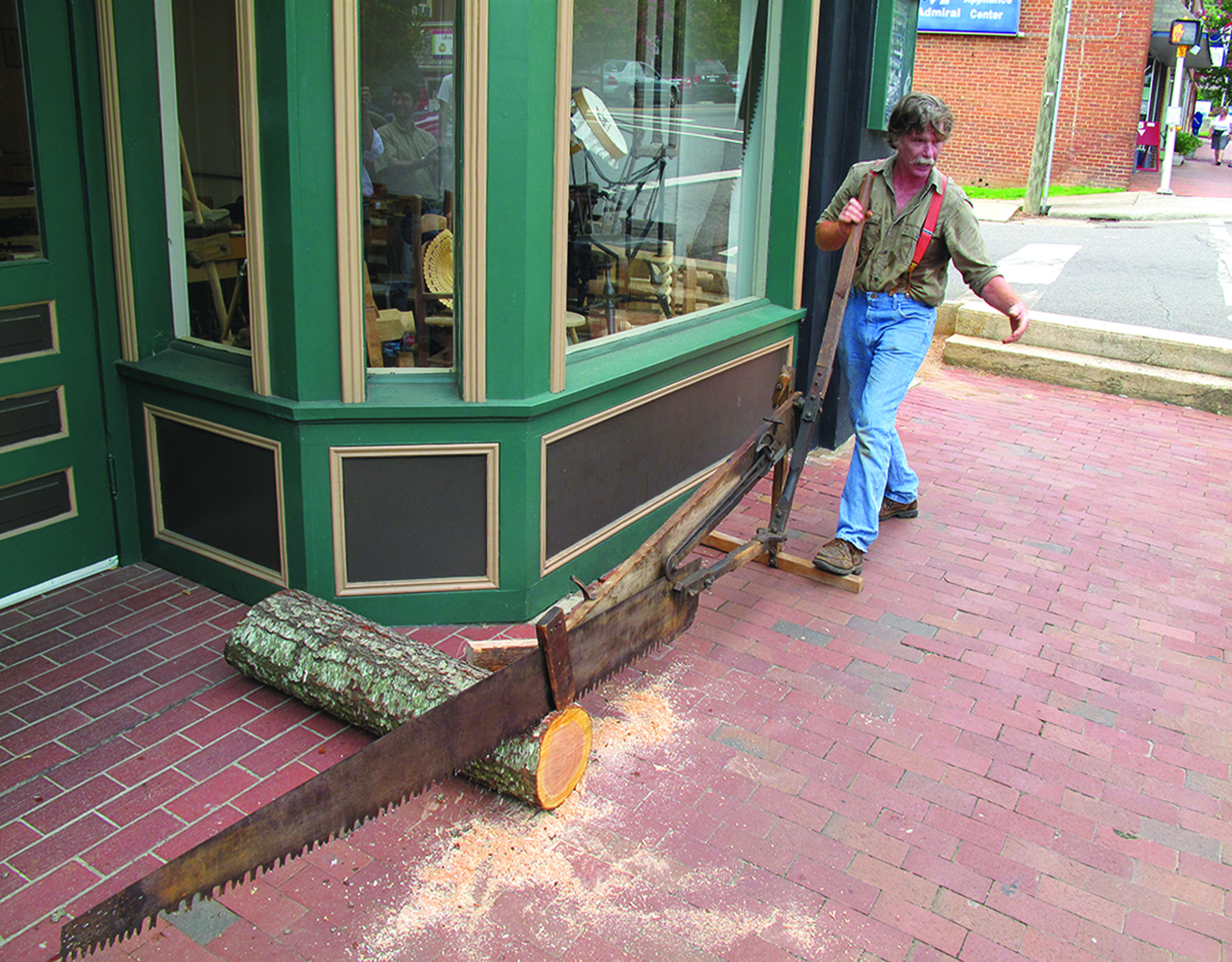
Always time for a show. At least once a day during classes, Roy takes the action outside where the townsfolk gather to watch and laugh. Here Underhill is demonstrating a one-man log-cutting saw.
After graduate school, Roy was teaching in 1975 and 1976 and trying to scrape by as a craftsman, building rakes, shovels and woodenware using hand tools. After Jane and Roy’s first daughter was born, he realized they couldn’t live without money anymore.
“We had to pay the hospital the $250 to bring Rachel home.”
Roy had proposed a television show on traditional woodworking to the North Carolina public television system. After some debate, his idea was greenlighted. And about 20 minutes after that, Colonial Williamsburg called. Roy had applied there to work in case the television gig didn’t work out.
He decided to do both.
And so begins the part of Roy’s public life that has been well-recorded. He became the first master housewright at Williamsburg, and his television show, “The Woodwright’s Shop,” became the longest-running how-to show on public television. It started airing in 1979 and continues to this day.
During that time, Roy has remained steadfast in his devotion to hand work. In fact, he tells the guests on his show that they should pretend that power tools don’t even exist. This is said right before he whips his entire production staff with a foam noodle.
Still, the idea sticks. “The Woodwright’s Shop” has remained a singular voice that has always championed muscle power over every other kind of locomotion. And Roy has always sought to put hand work in its proper historical context, without a glossy varnish or a sugar coating.
And that’s what in part caused him to leave Williamsburg.
Roy says he loved a lot of the aspects of his 15 years at Williamsburg. He met artisans who he works closely with to this day. He got to explore and practice traditional woodworking. And he learned how to combine his theater training with his love of the craft to work with the public that visited Colonial Williamsburg.
But an escalating dispute with the resident architectural historian over accurate practice proved too much to bear. While constructing recreated slave quarters, Roy received plans calling for stick-and-clay chimneys to be covered from top to bottom with horizontal clapboards. “It was the final absurdity, but they were adamant, and that was the end of that.”
Roy continued on in Williamsburg for a few more years, still shooting the TV series and writing books, including one on intelligence theory applied to communication, and a novel about a radio woodworker set in the 1930s. “Slowly, though,” he says, “the relentless fife and drum music started to get to me. I knew I had to get out!”
New Digs, a New Life & an Old Mill
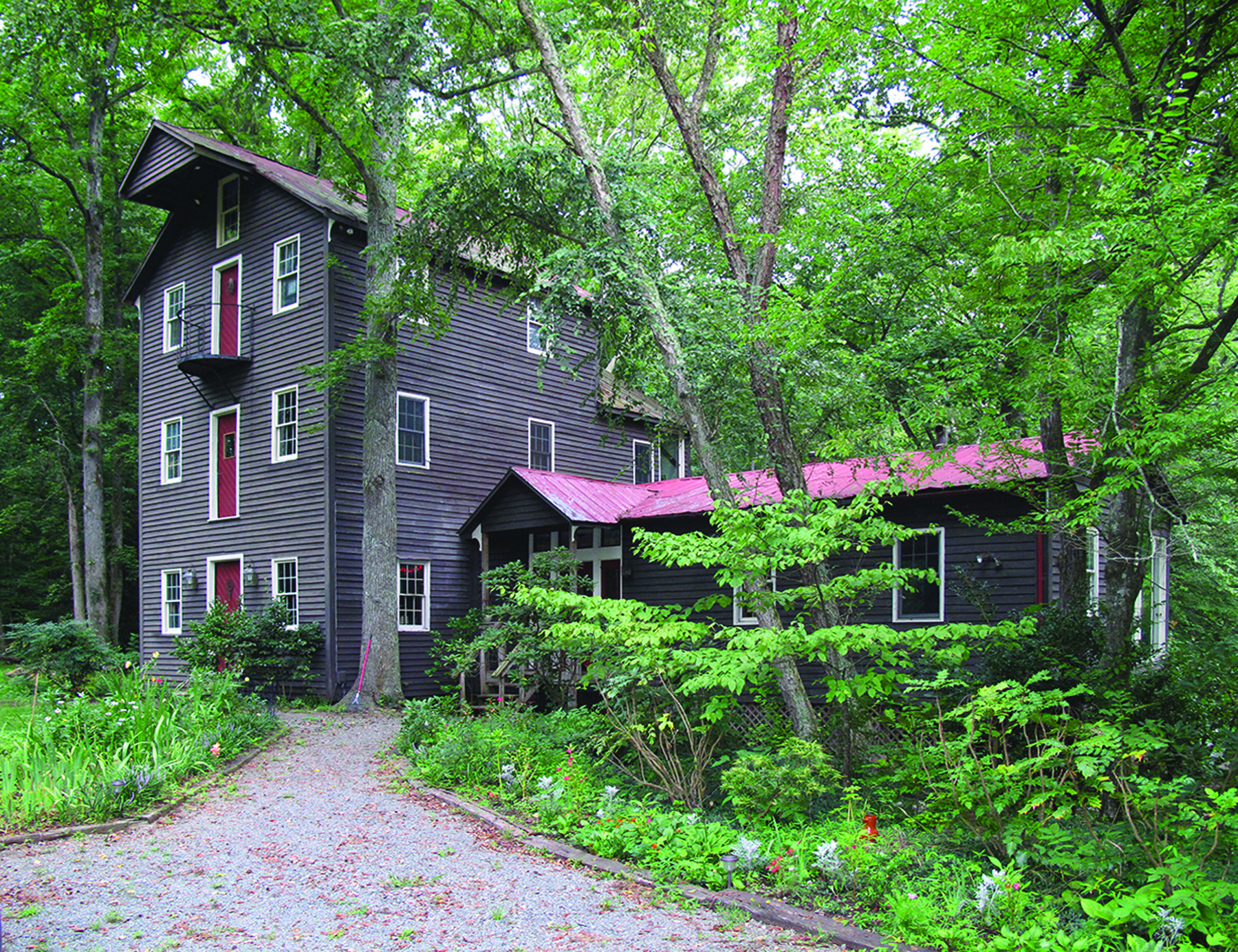
Milling about. The tall structure at the Underhill’s home is the original mill. The lower structure on the right is a bit more modern and contains the kitchen and living room.
When Roy Underhill and his wife, Jane, decided to open a woodworking school in Pittsboro, N.C., they left a settled life in Williamsburg, Va., to become experts in sweeping an old dam.
After establishing the school and setting up the workbenches there, the Underhills completed the move by purchasing an old mill in a nearby town that had been converted to a house and had last been occupied by a metal artist.
The artist had died after accidentally falling from the top floor of the mill. And despite that odd death, the structures and its surrounding grounds are vibrantly alive – with wildlife, an impossibly verdant landscape and Roy’s new workshop next to the mill.
Since acquiring the mill a few years ago, Roy has been juggling several flaming chainsaws as he has established his new school and kept his television show, “The Woodwright’s Shop,” running.

Clean that dam. The Underhill’s dam on a typical July evening. Time to grab a broom and sweep that stuff over the edge.
The mill itself has required a lot of work to keep it livable, from a new toilet to keeping the mill’s dam in order by sweeping it daily when debris accumulates behind it.
Up the hill from the mill, there is a little cottage that is Roy’s personal office and will eventually be a guest house for friends and instructors at the school. That structure needs new plumbing, walls, fixtures and a kitchen. Just some little stuff.
And Roy insists on doing all the work himself.
Or, as Jane puts it, “He is either very self-reliant or very cheap – I can’t decide which.”
Across the yard is Roy’s personal shop, which he has been working on just as much as the mill or the guest cottage. Here he has installed a sizeable shop floor using heart pine boards from an old chicken hatchery.
“You can hardly see any of the chicken poop on it,” Roy told me once.
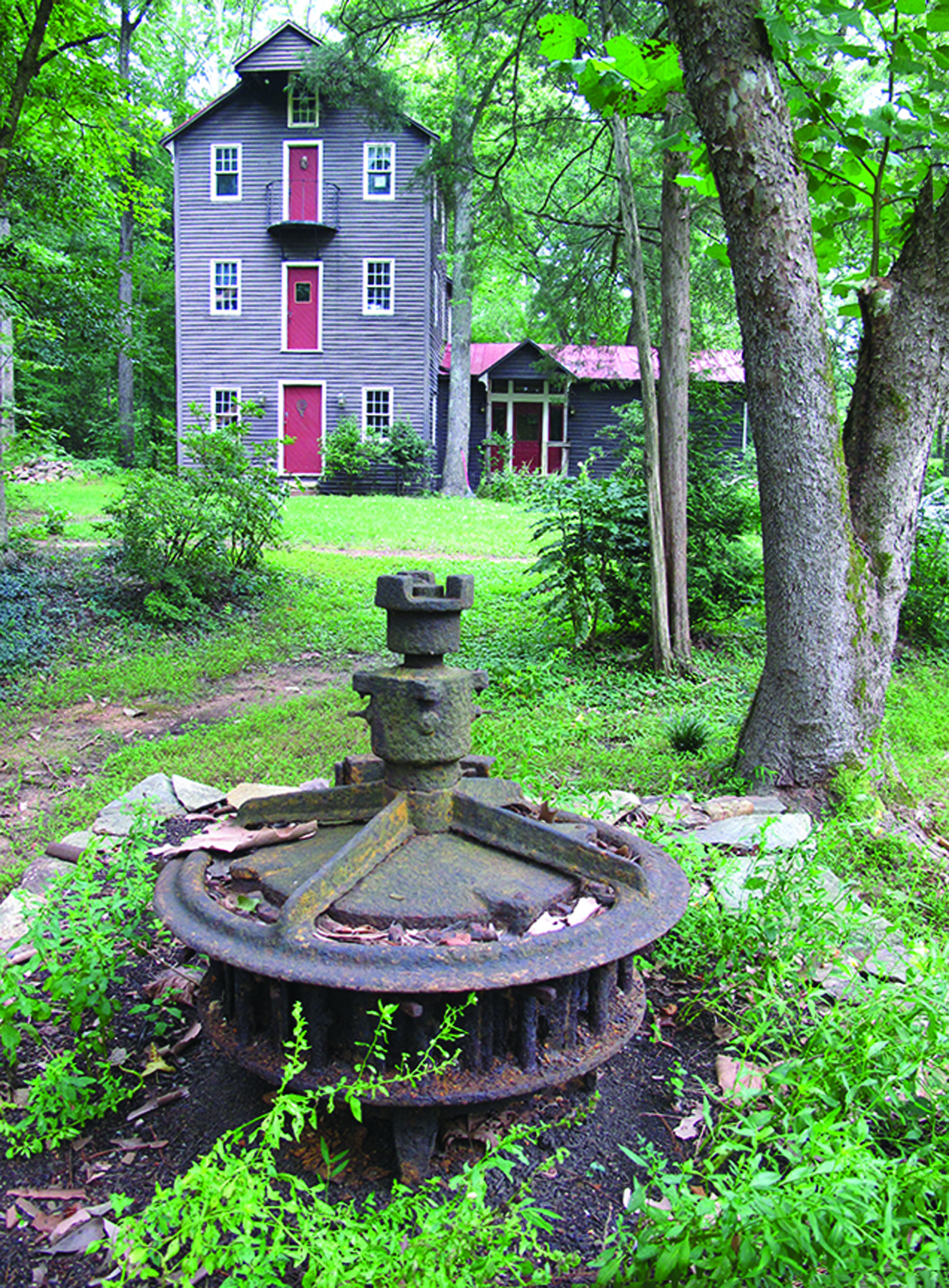
Disconnected. The original wheel for the dam now sits outside the mill as garden ornament.
He also has ripped out the shop’s 1970s windows and installed some incredible metal divided-light windows – also salvaged from the chicken hatchery.
Underhill uses this shop to teach some of his classes that are more “woodsy.” When Peter Follansbee needs to teach about riving oaks, this is where the class convenes. Underhill also teaches classes here on felling, splitting and sawing trees. There’s a saw pit for sawing lumber out back and lots of room to split material.
He also has a small area for forging metal and a near-endless landscape of tetanus-inducing objects. The old mill was once home to a crazy array of woodworking machinery, cotton presses and all manner of rolling mills.
And instead of selling the abandoned machinery for scrap, much of it is concealed under the vines and underbrush around the mill. There is even a complete old tractor where a mature tree has grown into the metal rim of one of its giant wheels.
But the biggest feature of the local landscape – the one that dwarfs even the occupants – is the stream itself that powered the mill. The Underhills watch the water like the weather. At times it gushes over the dam like white-water rapids. Other times it barely trickles over the stone rim.
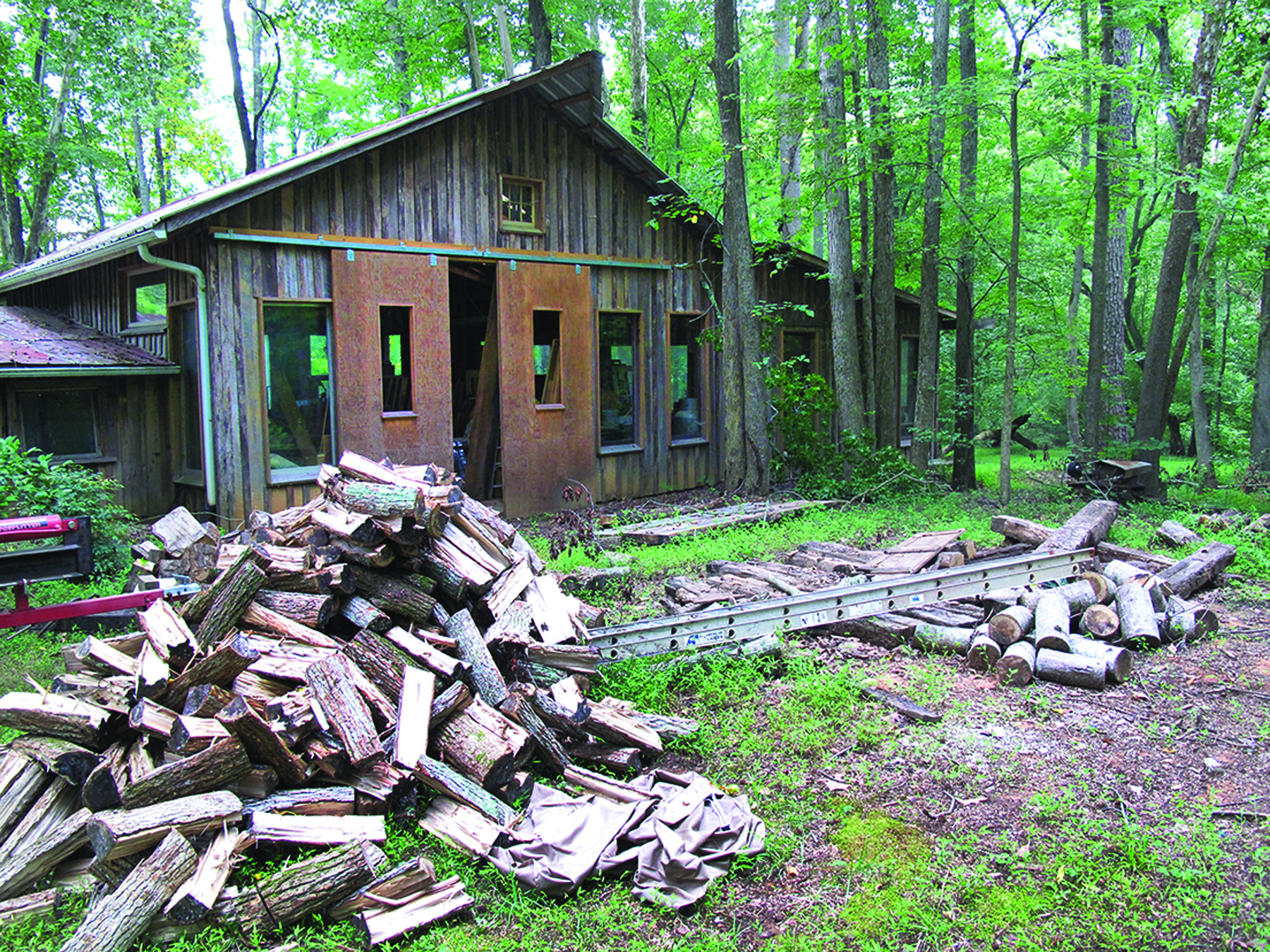
The home shop. In addition to the shop in Pittsboro, Roy is also restoring the shop at the mill for some classes.
It has to be watched. Roy shows visitors the high-water mark from the stream. It’s in his kitchen, about 5′ off the floor. The outlets, he says, were filled with river debris.
But the dam and the water aren’t just sources for worry. They are also a vibrant tapestry of life. There are otters who can be spotted by the patient observer – slow-moving beavers for the rest of us. There is a barred owl, who sits on a branch over the dam and gets bombarded by smaller birds when the owl gets too close to their nests.
And there are the Underhills, who watch it all from the back porch of their mill.
On any given morning you can find the couple sipping coffee as they stare out at the dam discussing the tasks ahead for the day – including who will sweep the dam that day.
Oh Yes, the Teaching
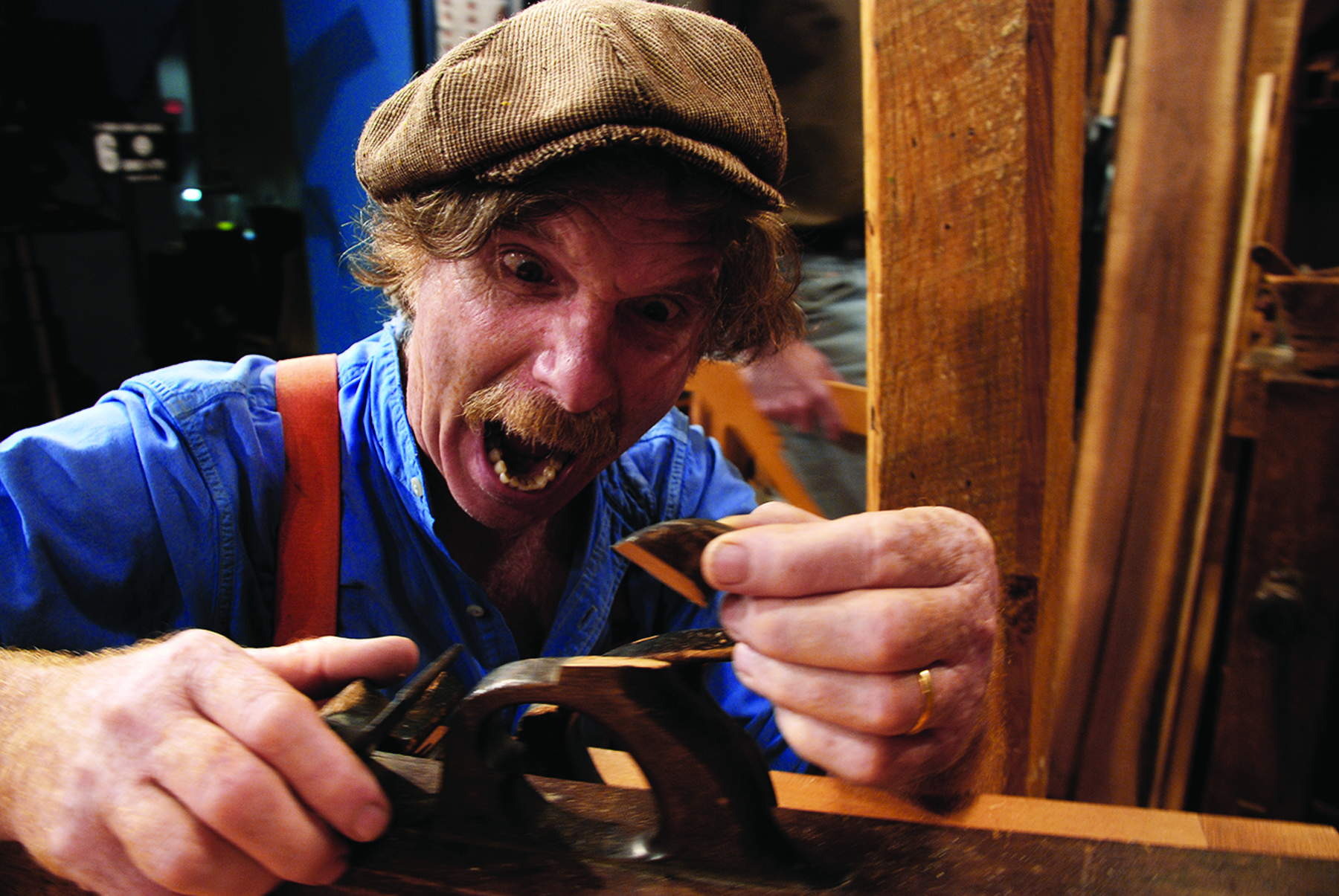
The agony. Even Roy makes mistakes. After breaking off the horn of the tote of one of his favorite try planes, he displays a typical woodworker’s reaction.
During this period of limbo, Roy did some work as a communications consultant, worked on his novel and tried to figure out the next step. Then he remembered how much he’d enjoyed teaching and having a live audience. So he founded The Woodwright’s School in Pittsboro, and bought an old mill nearby to live in with Jane, their dog and three cats.
The school has been a success. Perhaps too much of a success, and Roy says he has been stretched to the point where he is considering converting the school to a non-profit organization so he has a board of directors that can help run the school.
Roy teaches at his school quite a bit, but he also brings in other craftsmen, both local and international. And they usually end up appearing on “The Woodwright’s Shop” as well. So Roy does a lot of work and sees a lot of work. But despite all his years of building and building, Roy does not consider himself much of a craftsman.
“I’m a teacher. That’s all that I am,” he says. “But if you don’t have enough craftsmanship you can’t teach it. I look at my early stuff and think, ‘Hey, I could have been really good at this.’ But that was never my ultimate goal.”
Roy is absolutely selling himself short. Though many of the projects in his shop remain unfinished for years, his home is filled with the things he’s built and they stand in opposition to his comment above.
But there is no doubt about where Roy’s sympathies lie. On any given day at his school you’ll find him slaving at his bench at one task or another. But as soon as the front door opens, the bell rings and strangers walk in, Roy puts down his tools and walks over to greet the visitors.
There is subversion that needs doing.
Here are some supplies and tools we find essential in our everyday work around the shop. We may receive a commission from sales referred by our links; however, we have carefully selected these products for their usefulness and quality.







